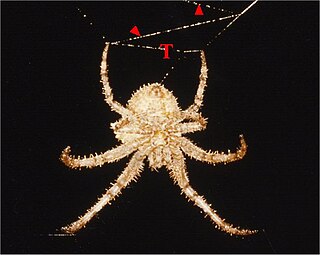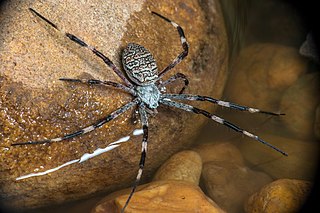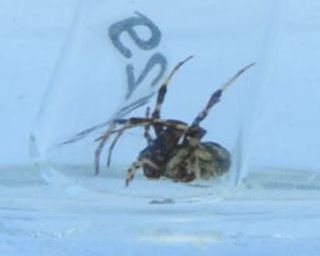
The genus Argiope includes rather large spiders that often have a strikingly coloured abdomen. These spiders are distributed throughout the world. Most countries in tropical or temperate climates host one or more species that are similar in appearance. The etymology of Argiope is from a Latin word argentum meaning silver. The carapace of Argiope species is typically covered in silvery hairs, and when crawling in the sun, they reflect it in a way that gives them a metallic, white appearance.

Orb-weaver spiders are members of the spider family Araneidae. They are the most common group of builders of spiral wheel-shaped webs often found in gardens, fields, and forests. The English word "orb" can mean "circular", hence the English name of the group. Araneids have eight similar eyes, hairy or spiny legs, and no stridulating organs.

Argiope keyserlingi is a species of orb-web spider found on the east coast of Australia, from Victoria to northern Queensland. It is very similar in appearance to a closely related north Queensland species, Argiope aetherea. A. keyserlingi is commonly found in large populations in suburban parks and gardens, particularly among the leaves of Lomandra longifolia. Like many species of orb-web spider, A. keyserlingi shows considerable sexual dimorphism, as the females are many times larger than the males. Mature females can be seen during the summer, and seeing multiple males on the web of one female is not uncommon.

Argiope aetherea is a common, large orb-web spider. Like other species of Argiope, it is commonly known as the St Andrew's Cross spider, due to the characteristic cross-shaped web decorations female spiders often include in their webs. A. aetherea is similar in appearance to A. keyserlingi, however female A. aetherea are generally larger than A. keyserlingi. Like most orb-web spiders, A. aetherea shows considerable sexual size dimorphism, with females being many times larger than males.

Argiope picta is a species of orb web spider found in tropical areas of Queensland, Australia and Papua New Guinea up to the Moluccas. This species is similar in size to the sympatric Argiope aetherea; females can be distinguished from those of A. aetherea via extensive differences in abdominal colouration and patterns. The males of these two species are almost indistinguishable.

Micrathena, known as spiny orbweavers, is a genus of orb-weaver spiders first described by Carl Jakob Sundevall in 1833. Micrathena contains more than a hundred species, most of them Neotropical woodland-dwelling species. The name is derived from the Greek "micro", meaning "small", and the goddess Athena.

Kaira, sometimes called frilled orbweavers, is a mostly neotropical genus of orb-weaver spiders first described by O. Pickard-Cambridge in 1889. It includes sixteen described species that occur from South America up to the southern and eastern USA. It is presumably related to Aculepeira, Amazonepeira and Metepeira.
Amazonepeira is a genus of South American orb-weaver spiders first described by Herbert Walter Levi in 1989.
Dubiepeira is a genus of South American orb-weaver spiders first described by Herbert Walter Levi in 1991.
Hingstepeira is a genus of South American orb-weaver spiders first described by Herbert Walter Levi in 1995.
Lewisepeira is a genus of orb-weaver spiders first described by Herbert Walter Levi in 1993.
Manogea is a genus of Central and South American orb-weaver spiders first described by Herbert Walter Levi in 1997. As of April 2019 it contains only three species.
Nicolepeira is a genus of South American orb-weaver spiders first described by Herbert Walter Levi in 2001. As of April 2019 it contains only three species, all found in Chile.
Rubrepeira is a genus of orb-weaver spiders containing the single species, Rubrepeira rubronigra. It was first described by Herbert Walter Levi in 1992, found from Mexico to Brazil.
Tatepeira is a genus of Central and South American orb-weaver spiders first described by Herbert Walter Levi in 1995.

Argiope magnifica is a species of orb web spider found in tropical areas of north-east Queensland, Australia, eastern Papua New Guinea and the Solomon Islands. It is commonly known as the magnificent St Andrew's cross spider. This species is similar in size to the sympatric Argiope keyserlingi; females can be distinguished from those of A. keyserlingi via extensive differences in abdominal colouration and patterns. The males of these two species are almost indistinguishable.

Argiope radon is a species of orb web spider native to Australia. It is found in tropical areas of the Northern Territory, Western Australia and Queensland. It is commonly known as the Northern St Andrew's cross spider.

Argiope katherina is a species of orb-weaver spider found in the northern parts of the Northern Territory and Western Australia. It was first described by Levi in 1983 and was named for Katherine Gorge. Specimens had been found at the mouth of split rock crevices up to one hundred metres from the Katherine River in sparse Pandanus-dominated territory.

Argiope dietrichae is a rare species of orb-web spider found in the northern parts of Western Australia and the Northern Territory. It was first described by Levi in 1983, and it was named for Amalie Dietrich who collected specimens for the Godeffroy Museum in Hamburg.

Gea eff is a species of orb-weaver spider. It is found in Papua New Guinea. The arachnologist Herbert Walter Levi formally described the species in 1983. While it was still undescribed, Michael H. Robinson and colleagues reported on its courtship and mating behaviors. Gea eff has the shortest scientific name of any spider species.











